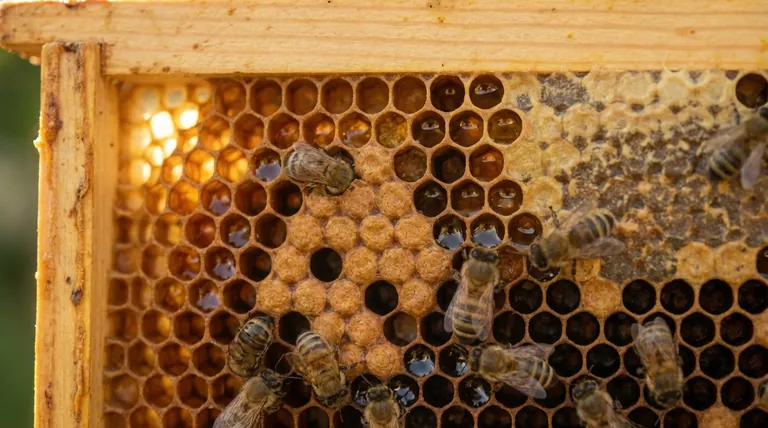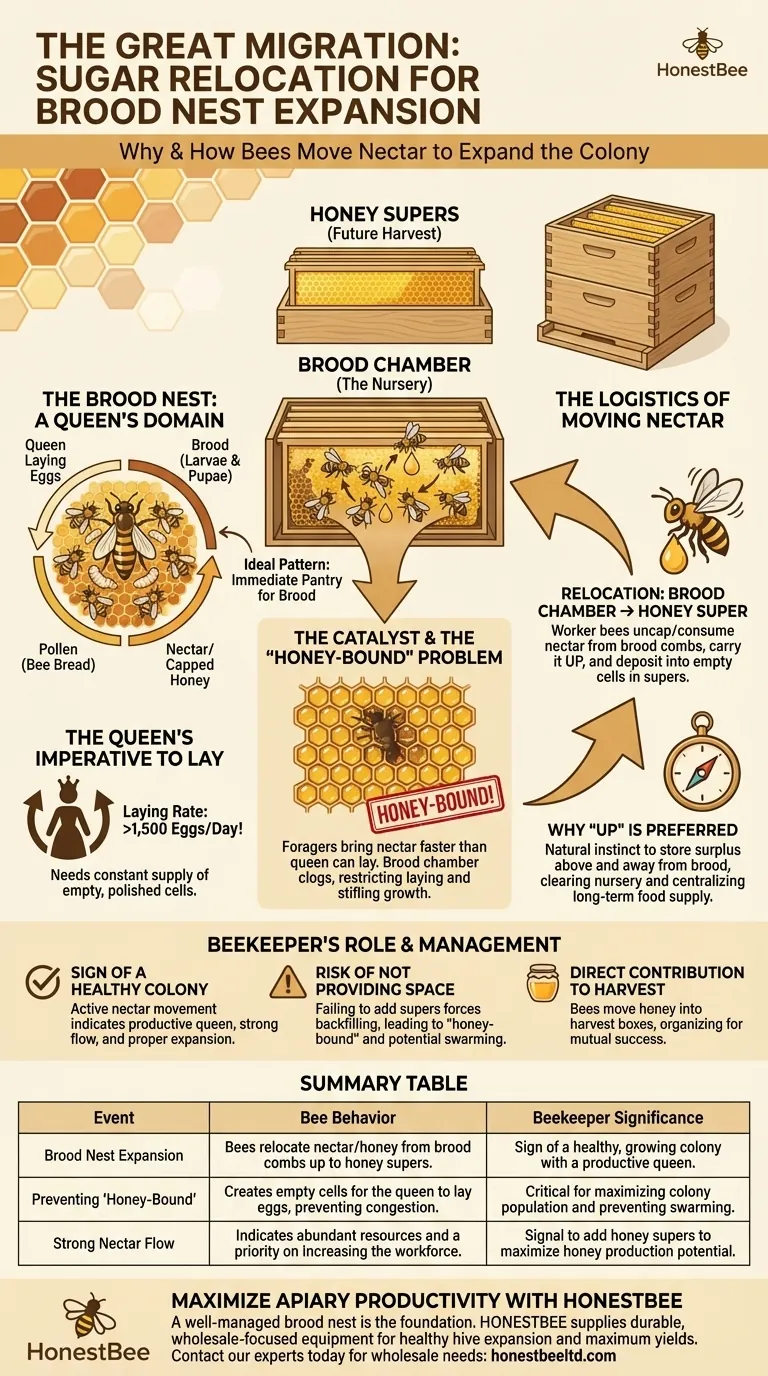During a period of brood nest expansion, worker bees will actively relocate stored nectar and honey to make room for the queen to lay more eggs. This sugar is typically moved from the brood combs up into the honey supers, the area designated by beekeepers for honey storage and eventual harvest.
The movement of sugar out of the brood nest is not a random act; it is a clear signal of a healthy, growing colony prioritizing the expansion of its next generation over immediate food storage in its core living space.

The Brood Nest: A Queen's Domain
To understand why bees move their stores, you must first appreciate the function of the brood nest. It is the heart of the colony, a carefully managed nursery dedicated to a single, critical purpose: raising new bees.
Why Brood Space is Prime Real Estate
The central combs of the hive are where the queen lays her eggs. Worker bees maintain this area at a precise temperature and humidity, making it the most valuable and resource-intensive part of the hive.
The Ideal Brood Pattern
A healthy brood nest often shows a distinct pattern. The queen lays eggs in the center of a comb, creating a patch of brood. The worker bees then store a band of pollen (bee bread) around the brood, followed by an outer arc of nectar or capped honey. This arrangement serves as an immediate, accessible pantry for feeding the developing larvae.
The Catalyst: A Need for More Space
This organized system is dynamic. During a strong nectar flow in spring or summer, the colony's priorities shift toward rapid population growth to maximize the foraging workforce.
The Queen's Imperative to Lay
With abundant incoming nectar and pollen, a productive queen can increase her laying rate to over 1,500 eggs per day. To do this, she needs a constant supply of empty, polished cells within the core brood nest.
The "Honey-Bound" Problem
If foragers bring in nectar faster than the queen can lay, they will begin to store it in any available empty cell, including those in the brood nest. When the brood chamber becomes clogged with nectar, it is called being honey-bound or nectar-bound. This is a serious issue that physically restricts the queen's ability to lay, stifling colony growth.
The Logistics of Moving Nectar
To prevent the brood nest from becoming honey-bound, worker bees will actively relocate these stores.
From the Brood Chamber to the Super
The process is straightforward. House bees will uncap cells of honey or consume fresh nectar from the brood combs. They then carry it up through the hive and deposit it into empty cells in the honey supers placed above the brood boxes.
Why "Up" is the Preferred Direction
Bees have a natural instinct to store their surplus food reserves above and away from the main brood-rearing area. This keeps the nursery clear for the queen and centralizes the colony's long-term food supply in a location that is efficient to access and defend.
Understanding the Beekeeper's Role
This behavior is a critical signal for the beekeeper. Observing and managing this process is key to a successful season.
A Sign of a Healthy, Growing Colony
When you see bees moving nectar upwards, it is a positive sign. It indicates you have a productive queen, a strong nectar flow, and a colony that is expanding as it should.
The Risk of Not Providing Space
If a beekeeper fails to add honey supers in time, the bees have nowhere to move the nectar to. This forces them to backfill the brood nest, leading to the "honey-bound" condition that can limit population and even trigger swarm preparations.
A Direct Contribution to Your Harvest
This behavior is precisely what beekeepers want to see. The bees are actively moving honey into the boxes you intend to harvest, organizing the hive for both their success and yours.
How to Manage Brood Nest Expansion
Your management strategy should align with the bees' natural instincts. By providing the right space at the right time, you facilitate their success.
- If your primary focus is maximizing colony population: Ensure the queen always has ample laying space by adding supers well ahead of when they are needed.
- If your primary focus is maximizing honey production: View the movement of nectar as the key indicator that it is time to add another honey super to capture the full potential of the nectar flow.
- If you are concerned about swarming: Proactively managing brood nest congestion is one of the most effective swarm prevention techniques.
By understanding that bees move nectar to prioritize brood, you can work with their instincts to build a stronger, more productive colony.
Summary Table:
| Event | Bee Behavior | Beekeeper Significance |
|---|---|---|
| Brood Nest Expansion | Bees relocate nectar/honey from brood combs up to honey supers. | Sign of a healthy, growing colony with a productive queen. |
| Preventing 'Honey-Bound' | Creates empty cells for the queen to lay eggs, preventing congestion. | Critical for maximizing colony population and preventing swarming. |
| Strong Nectar Flow | Indicates abundant resources and a priority on increasing the workforce. | Signal to add honey supers to maximize honey production potential. |
Maximize your apiary's productivity with the right equipment. A well-managed brood nest is the foundation of a strong colony and a successful harvest. HONESTBEE supplies commercial apiaries and beekeeping equipment distributors with the durable, wholesale-focused supplies needed to support healthy hive expansion and maximize honey yields. Contact our experts today to discuss your wholesale needs and build a more productive operation.
Visual Guide

Related Products
- Professional 3-Bar Frame Grip with Integrated Hive Tool
- Professional 500g Sectional Comb Honey Frame System for Beekeeping
- Professional Frame Comb Fork and Lifter for Efficient Handling
- HONESTBEE Professional Long Handled Hive Tool with Precision Cutting Blade
- Automatic Honey Flow Beehive 4 Frame Mini Hive for Beekeeping
People Also Ask
- What are the benefits of using Frame Grips in beekeeping? Boost Efficiency & Protect Your Hive
- What parts of bee equipment should be painted? A Guide to Protecting Your Hive and Your Bees
- What should beginners consider when purchasing beekeeping equipment? A Guide to Essential Starter Gear
- What does every bee keeper need? Your Essential Guide to Starting Strong
- How should Frame Grips be maintained after use? A Guide to Biosecurity and Tool Longevity



















